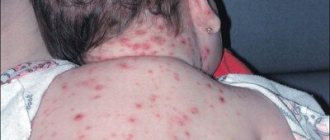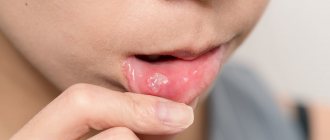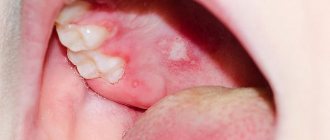From this article you will learn:
- what to do if a child has an abscess on his gum,
- Do I need to remove a baby tooth?
- how the treatment is carried out (video),
- how to distinguish a purulent lump from a cyst on a child’s gum.
The article was written by a dentist with more than 20 years of experience.
An abscess on the gum in children usually looks like a red or yellowish lump located in the projection of the root of one of the teeth, which caused the inflammation. The inside of such a lump is filled with pus, and it has a yellowish color if the mucous membrane is thin and then the pus shines through it. The appearance of such a lump on the gum above a tooth in a child is always evidence of the development of purulent inflammation at the apex of the roots of a baby or permanent tooth, and indicates the development of apical periodontitis.
Apical periodontitis of primary and permanent teeth in children is most often associated with the lack of timely treatment of caries and pulpitis, as well as with mechanical trauma to the front teeth, for example, due to a fall. Therefore, caries or an old filling can always be found on the causative tooth, and if we are talking about an injury, there may be a chip of the enamel or a fracture of the tooth crown. In cases where the traumatic impact does not lead to damage to the hard tissues of the tooth, the crown of the tooth may be stained bluish or gray.
Abscess on a child’s gum: photo
Immediately before an abscess appears on the gum, children usually complain of pain or discomfort in one of the teeth, which is associated with the formation of pus at the apex of the tooth root. But after a pus-filled lump forms on the gum, children in most cases immediately feel relief (only pressing on the lump with your fingers can remain painful). Next, the lump may spontaneously open with the formation of a fistula, from which pus will leak into the oral cavity, or this may require an incision in the gums.
Important: however, not every lump on the gum indicates the development of purulent inflammation. There are also so-called eruption cysts. For example, even 2-3 weeks before the eruption of a baby or permanent tooth, a cyst may form on the child’s gum, which will have a bluish color (Fig. 7-8). We will also talk about such cysts at the end of the article.
What does a purulent abscess on a child’s gum look like (video) –
Causes of stomatitis
Inflammation of the oral mucosa can be caused by various reasons.
- Mucosal injury6.
- Viral, bacterial or fungal infection6.
- Allergy2.
- Immunity disorders (autoallergy, that is, a reaction to one’s own altered tissues2).
- Diseases of the blood, digestive, cardiovascular, nervous and endocrine systems2.
- Hypovitaminosis - lack of vitamins C, B1, B12, E, D32.
- Common infectious processes: measles, rubella, scarlet fever and diphtheria, infectious mononucleosis, tuberculosis and others1.
Only a specialist can understand the causes of stomatitis. Therefore, if symptoms of the disease appear, you should definitely contact your dentist.
Inflammatory diseases of the oral cavity can occur in a child of any age6. Immaturity of the body is the primary factor predisposing to the occurrence of stomatitis in children under one year of age. The mucous membrane of the oral cavity during this period of a child’s life is very vulnerable, its natural protective properties are reduced. The immunity received from the mother during fetal development and which protected the baby immediately after birth weakens every day. Therefore, the infection easily penetrates the mucous membrane and causes its inflammation. Most often at this age, candidal stomatitis occurs, commonly called thrush1,6.
From the age of one to 3 years, children actively develop immune mechanisms to protect the oral mucosa (local immunity), but its permeability to viruses remains extremely high. Therefore, in a 2-3 year old child, stomatitis is more likely to be viral, in the vast majority of cases - herpetic1,3,4.
From 4 to 12 years of age, stomatitis in children is more often caused by allergic and autoimmune reactions. In particular, chronic aphthous forms of the disease occur during this period1.
Up to contents
How do the symptoms of stomatitis manifest in children?
With stomatitis, the child feels pain in the mouth, and his body temperature rises. If you notice your baby is weak and refuses to eat, check him for other symptoms of stomatitis:
- redness in the mouth;
- bleeding gums;
- increased salivation;
- white or yellow plaque on the gums;
- bad breath;
- ulcers in the mouth.
Based on the symptoms, there are 3 types of stomatitis.
Catarrhal stomatitis
This type of disease mainly appears due to dental problems (most often catarrhal stomatitis provokes caries). It is characterized by redness, swelling in the mouth and inflammation of the gums.
Aphthous stomatitis in children
It got its name due to the fact that it causes aphthae to appear in the mouth. These are small round or oval ulcers, framed by a red border and with a yellowish coating in the center. As a rule, 2-3 spots appear, which are located on the lips, cheeks or tongue. They are accompanied by clear redness in the affected areas.
Herpetic stomatitis in children
Occurs when the immune system is very weakened. This may first happen when a mother stops breastfeeding her baby. During this period, antibodies from breast milk no longer help his immune system fight viruses.
Thus, in the process of developing its own defense, the child is exposed to the influence of many viruses, in particular herpes. Sometimes stomatitis occurs in a newborn if the child has recently been transferred to artificial nutrition.
The disease is identified by a multitude of blisters, which tend to quickly burst and form ulcers. Such symptoms can last up to a week and are accompanied by fever.
Traumatic stomatitis
Inflammation of the mucous membrane in the mouth can be preceded by trauma: mechanical, thermal, chemical, radiation1,6.
Small children who put everything in their mouths can injure the mucous membranes with the sharp edges of toys or household items. Injuries often occur due to inept use of cutlery as a result of falls. In older children, stomatitis may be associated with a thermal burn, blows to the teeth, or the bad habit of chewing a pencil or pen. Sometimes the cause of inflammation is dental diseases and their treatment: sharp edges of damaged teeth and fillings, braces and aligners1.
When stomatitis develops in a child on the gum, on the inner surface of the cheek or in another place, the mucous membrane becomes red and swollen, and a painful erosion or ulcer may appear in the area of damage. Since there are many microorganisms in the mouth, there is always a risk of a bacterial or fungal infection1.
If the mucous membrane is constantly injured, painless whitish or whitish-gray layers may form on it.
In children under 1 year of age, stomatitis can be the result of using the wrong nipples: long, tight, irregularly shaped. The resulting Bednar aphthae are located in the area of the transition of the soft palate to the hard palate and are round erosions or ulcers1.
Treatment of traumatic stomatitis in children includes:
- elimination of traumatic factors;
- rinsing the mouth, irrigating the mucous membranes and treating wounds with drugs with an analgesic and antiseptic effect1.
Up to contents
What is stomatitis
Stomatitis is an inflammatory disease of the gums that appears externally as white spots or sores on the gums.
You should not ignore stomatitis or try to treat it yourself. Mouth ulcers occur for various reasons, sometimes quite serious. If a white sore appears on the gum, it is important not only to get rid of the symptoms, but to understand the cause of its appearance, because stomatitis in adults often manifests itself as a secondary process of some disease, which is best diagnosed with the help of doctors in a timely manner.
What does stomatitis look like?
Stomatitis is an inflammation of the lining of the mouth that causes ulcers, blisters and spots.
White sores can appear throughout the mouth: a white spot can be on the gum, tongue, lips, cheeks, and so on. Ulcerative damage to the integrity of the oral mucosa can cause severe discomfort, pain, provoke an increase in the sensitivity of nerve endings, and an increase in body temperature. It would seem that a minor white sore on the gum not only prevents you from eating normally, but also from sleeping and drinking, which can lead to problems with the gastrointestinal tract. If you have developed stomatitis, its signs are quite obvious - a white sore appears on the gum, and your general condition may worsen significantly. In this case, you should not delay visiting a doctor.
Stomatitis causes inflammation of the oral mucosa, which causes ulcers, blisters and spots to appear.
Symptoms of the disease
Stomatitis has its own characteristic signs, by which a specialist quickly identifies the disease:
- sores, vesicles, blisters on the gums;
- inflammation of the gums;
- swelling, pain, redness of the oral mucosa;
- hyperemia of the gums and mucous membranes;
- white or yellow coating;
- increased salivation (hypersalivation);
- bleeding gums;
- bad breath;
- unpleasant putrid taste in the mouth;
- enlargement of the submandibular lymph nodes;
- increase in temperature;
- general deterioration of health.
With stomatitis, the patient's well-being can seriously deteriorate.
Where can stomatitis occur:
- most often stomatitis occurs on the gums, both the upper and lower jaws;
- buccal mucosa;
- lips;
- sky.
The mechanism of development of stomatitis and causes of occurrence
The mechanism of development of this disease has not been precisely established, and today it is believed that it is based on an immune reaction to various irritants - presumably, their role is played by molecules that the immune system is not able to recognize. As a result, lymphocytes attack unidentified molecules, which leads to stomatitis on the gums in adults and children.
Stomatitis is often a manifestation of a number of systemic diseases, such as vitamin deficiency, endocrine diseases, blood diseases, gastrointestinal tract and others.
Among the local factors for the formation of ulcers on the gums, the following causes of stomatitis are distinguished:
- microorganisms (viruses, mycoplasmas, bacteria);
- diseases of the oral cavity and gastrointestinal tract (for example, colitis, gastroduodenitis, gastritis) can provoke catarrhal stomatitis;
- poor oral hygiene;
- herpes on the lips;
- dehydration;
- dentures of low quality, as well as incorrectly installed ones;
- use of certain medications;
- mechanical injury to the gums and mucous membranes of the mouth;
- vitamin deficiency and hypovitaminosis;
- insufficient intake of vitamins;
- smoking;
- chronic systemic diseases;
- oncological diseases of the neck and nasopharynx;
- side effects of chemotherapy;
- hormonal imbalances.
Sometimes stomatitis appears after dental treatment. If the cause of the disease is identified and eliminated in time, it is possible to cure it quickly and effectively.
Is stomatitis contagious and how is it transmitted?
Stomatitis itself is not a contagious disease, but the underlying cause is contagious, for example, the herpes simplex virus in herpetic stomatitis or an RNA virus in vesicular stomatitis. In these cases, stomatitis can develop as a consequence, as a variant of the body’s response to the causative virus.
If stomatitis occurs due to other reasons: mechanical damage, vitamin deficiency, hormonal imbalance, it does not pose any danger in terms of infection.
Viral stomatitis
About 80% of all stomatitis in children is caused by herpes viruses3,5. In approximately 70% of cases, the disease develops in children aged 1 to 3 years3,4.
The disease can occur in mild, moderate and severe forms.
With mild herpetic stomatitis, the general condition is practically not disturbed. Body temperature does not exceed 37-37.50 C. Symptoms of inflammation are limited to swelling of the gums and usually the simultaneous appearance of single painful herpetic blisters and erosions on the mucous membrane (no more than 6). After 1-2 days, the contours of the lesions are blurred, the rashes turn pale, and the erosions heal without scarring3.
With moderate stomatitis, the child’s temperature reaches 38-390 C and lasts until rashes continue to appear. General intoxication manifests itself in the form of weakness, headache, nausea. The child becomes capricious, lethargic, refuses to eat and play3.
As the temperature rises, the oral mucosa becomes red and swollen, and the gums begin to bleed. The number of herpetic elements reaches 20-25, repeated rashes are accompanied by fever3.
Severe stomatitis in children looks like a common acute infectious disease and is accompanied by severe intoxication: fever 39-400 C, chills, headache, aching muscles and joints, heart rhythm disturbances, nosebleeds, nausea and vomiting. The number of herpetic elements can reach 100; they are located not only in the mouth, but also on the skin of the face, on the eyelids and conjunctiva of the eyes, and earlobes. In addition, upper respiratory tract symptoms may be present.3
Treatment includes treating the affected area with painkillers and antiseptic drugs, antiviral therapy, drinking plenty of fluids, a balanced diet and proper nutrition3,5.
Up to contents
Candidal stomatitis
In 80% of healthy children, Candida fungi can be found in the oral cavity. They get there during childbirth, from nipples and pacifiers, from care products, in contact with the mother's skin, with food during eating and usually do not cause any problems. Candidal stomatitis, or thrush, occurs when immunity decreases1.
Predispose to the disease:
- prematurity and postmaturity;
- developmental defects and concomitant diseases;
- treatment with antibiotics and hormones;
- artificial feeding;
- poor care and poor feeding hygiene;
- Using the wrong nipples1.
What does candidal stomatitis look like? In children's mouths, whitish or whitish-gray dotted formations appear on the reddened mucous membrane. They merge into films of a cheesy nature; when the films are rejected, bright red painful erosions are formed. Because of the pain, the baby becomes restless, cries often, sleeps poorly, and refuses to eat1.
In severe cases of candidiasis, a cheesy coating may appear on the palate and on the lateral surfaces of the tongue, on the tonsils and the back wall of the pharynx - candidal tonsillitis and pharyngitis develop1.
If your child has a fungal infection, you should always consult a doctor; he will tell you how and what to treat the mucous membrane with candidal stomatitis, so that the child does not have complications and recovers faster. Treatment, as a rule, involves treating the oral cavity with drugs with antifungal activity (chlorhexidine, hexethidine). In severe cases of the disease, antifungal agents, probiotics and immunomodulators are prescribed1.
Up to contents
Symptoms of gingivitis in children of various types
The very first symptom of gingivitis is bleeding gums. This is a kind of beacon that signals the beginning of the inflammatory process. However, often this sign goes unnoticed, and the child goes to the dentist only at the stage of an active inflammatory process, manifested by swelling of the gums, which have become bright red, bad breath in the child, pain and burning. Sometimes this condition is accompanied by mild malaise and a slight increase in temperature.
Catarrhal
Most often, children suffer from catarrhal gingivitis. Its chronic form proceeds sluggishly, for a long time, the child practically does not complain of pain, but may refuse to brush his teeth due to the pain that arises in the process. Chronic catarrhal gingivitis usually occurs as a result of poor oral hygiene. There is swelling of the gums, their redness, sometimes single ulcers and cyanosis of the gums. Acute catarrhal gingivitis occurs as a result of an accidental injury to the mucous membrane, a burn, or may be one of the symptoms of a viral disease or allergy. But most often this form of gingivitis occurs during the eruption of baby teeth and their replacement with permanent ones.
Ulcerative
Ulcerative gingivitis can be triggered by an infectious process and hypothermia - for example, if a child spent too much time walking or contracted a viral or bacterial infection from friends in kindergarten or school. But more often it develops as a worsening of the catarrhal form of gingivitis, which was left without treatment. The first symptoms are bleeding, pain and itching in the gums. This is followed by swelling, redness and areas with small ulcers. If this stage of the disease is left untreated, ulcerative necrotic gingivitis will follow, which is characterized by already necrotic areas of the gums with a dirty gray-green coating, putrid odor from the mouth, abundant plaque on the teeth, and viscous saliva. All this leads to intoxication of the child’s body; as a result, he sleeps poorly, is constantly capricious and eats little due to the pain that chewing food causes to his inflamed gums.
Hypertrophic
With hormonal diseases and during puberty, the hypertrophic form of gingivitis is more common in children. This chronic inflammation of the gums is characterized by an overgrowth of gum tissue, which can partially cover the crowns of the teeth. Usually the process covers one or both gums, rarely - only an area limited to several teeth (such localized hypertrophic gingivitis occurs in children due to any anomalies of the dental system).
Atrophic
Atrophic gingivitis is usually caused by improper orthodontic treatment or dental abnormalities. This form of gingivitis is usually localized (found in the area of the lower front incisors and canines). The inflammatory process in atrophic gingivitis is not pronounced, the color of the gums practically does not change, the child does not complain of pain. But over time, the neck of the tooth, and sometimes its root, is exposed, and unpleasant, often painful sensations appear.
Allergic stomatitis
Allergic damage to the mucous membrane most often occurs in the form of contact stomatitis and chronic aphthous form of the disease1.
Allergens can include medications, food products, varnishes and paints that coat toys, toothpastes, mouth rinses, chewing gum, and dental metals included in braces1,2.
With allergic stomatitis in children, erosions and ulcers may appear in the mouth, but more often the matter is limited to redness and swelling of the mucous membrane1.
Treatment is avoiding contact with the allergen, rinsing or irrigating the mouth with antiseptic solutions to prevent infection. If necessary, doctors recommend taking antihistamines1,2.
Chronic recurrent aphthous stomatitis often occurs in schoolchildren and adolescents due to allergies2. In addition, its development can be provoked by diseases of the gastrointestinal tract, upper respiratory tract infections, disorders of the nervous system, and hypovitaminosis1,2.
With aphthous stomatitis in children, itching and burning first appear in the oral cavity. The mucous membrane at the site of the lesion becomes red and swollen, then an aphtha forms on it - a round or oval erosion 0.5-1 cm in diameter rising above the surrounding tissues with a red rim along the periphery and a bottom covered with a grayish-white coating. Aphthae are extremely painful, and if many of them form, they cause significant distress to the child1,2.
How many days does aphthous stomatitis last in children? With a mild course of the disease, the elements of inflammation persist for up to 5-7 days, then they heal without scar formation2 and do not appear for quite a long time. However, in severe cases, aphthae can occur constantly, and then many elements of inflammation can be found on the mucosa at different stages of development1,2.
To treat aphthous stomatitis, doctors use:
- antihistamines;
- immunomodulatory drugs;
- vitamins;
- probiotics2.
As a local therapy, it is recommended to treat the mucous membrane with drugs with analgesic, antiseptic, proteolytic (protein-breaking), anti-inflammatory and regenerating effects2.
Up to contents
What you need to know about gum disease in children
Healthy gums of a child are very vulnerable and delicate pale pink tissues that are easily subject to all kinds of injuries, which is not so typical for the tissues of the oral cavity of an adult. Fortunately, they are capable of rapid regeneration. It is also interesting that children’s gums can reflect the general condition of the body, acting as a litmus test for systemic diseases.
Among the most common diseases around dental tissues and gums
- Gingivitis
This inflammation occurs in 80% of children. The development of the disease in infants is facilitated by the adverse effects of general and local factors. - Gum atrophy
Up to 50% of the child population faces this serious problem. - Stomatitis
Various types of this disease are diagnosed most often in infants and preschool children. - Periodontitis
In this disease, inflammation develops in the periodontal tissues. About 5% of young dental patients are diagnosed with this condition. - Periodontal disease
Similar degenerative changes that affect periodontal tissues practically do not occur in childhood.
Gum diseases that most often occur in children
Inflammatory diseases
Gingivitis is an inflammation of the gums that occurs due to general or local exposure. Over time, untreated gingivitis can develop into periodontitis, that is, a condition where inflammation affects the periodontal tissues (bone tissue and muscle ligaments that hold the tooth in the jaw). In children, this disease is extremely rare, but still, preventive measures should not be neglected. If the development of a serious disease is not noticed in time, this can lead to loosening and further loss of the tooth. If gingivitis in a child responds well to treatment, and you can get rid of it without health consequences, then periodontitis, as a rule, becomes chronic, which is practically incurable.
The inflammatory process that accompanies the granulating form of periodontitis can provoke the formation of a cyst, and even the occurrence of a fistula on the gum. However, these complications are more typical for carious disease of dental tissues. Be that as it may, if you notice that the baby’s gums have acquired a bright red color, and deep grooves have appeared between the teeth and gums, and there is an unpleasant odor coming from the child’s mouth, then most likely the inflammation has affected not only the gums, but also deeper located periodontal tissues. You need to immediately contact pediatric dentistry, where the doctor will promptly prescribe comprehensive treatment.
Dystrophic diseases
Very often, infants and preschool children experience a pathology such as gum atrophy. The development of this negative phenomenon is facilitated by:
- incorrect orthodontic treatment;
- oral injuries;
- crowded teeth;
- all kinds of malocclusions.
Atrophy of gingival tissue is usually local in nature. It usually develops in the area of the canines and front incisors. The development of the disease is accompanied by mild inflammation. The child feels virtually no pain and has no complaints. After some time, degenerative changes cause exposure of the neck of the tooth and its root, the appearance of pathological sensitivity and severe pain.
Periodontal disease is a dystrophic disease that affects all periodontal tissues. This pathology practically does not occur in children. Its development is possible only in seriously ill babies whose immune systems are suppressed. Their body is in a state of deep vitamin deficiency. This disease is characterized by atrophy of the gums and other periodontal tissues. This incurable process can lead to complete resorption of bone tissue. In most cases, teeth that have already acquired unhealthy mobility cannot be saved. Only surgical intervention aimed at removing the affected tooth can bring a certain effect.
Risk factors
Local risk factors
Gum disease in children can be caused by a number of local factors:
- Microbes
Tartar, the formation of which is promoted by poor-quality oral cleaning, can provoke various gum diseases. First, yellow plaque accumulates on the teeth, in which pathogenic bacteria feel at ease. Then, at first glance, harmless plaque turns into hard dental deposits, which subsequently cause serious pathological changes in dental tissue and gums. - Teething
The development of gingivitis can be triggered by teething, as well as their replacement with permanent ones. - Uneven load on the dental system
This entails the development of malocclusion in the child, lethargy of chewing, the habit of chewing food on one side, a short frenulum of the tongue and lips contribute to the occurrence of gingivitis. - disruptions in the functioning of the endocrine system (adolescence and associated hormonal changes);
- diseases of the cardiovascular system;
- diseases of the gastrointestinal tract;
- respiratory system diseases;
- pathologies of the immune system, autoimmune diseases;
- hypo- and vitamin deficiency.
- swelling of the gums and bleeding;
- bad breath;
- burning and itching in the gums.
General risk factors
The following systemic diseases and changes in the functioning of body systems can provoke gum disease:
Attention: first signals!
The following factors can signal the development of gum disease in children:
The occurrence of these symptoms necessitates a visit to the dentist. The sooner the child receives help from a qualified specialist, the higher the likelihood of easy relief of the disease at the initial stage and the opportunity to reverse the nascent process.
Hexoral in the treatment of stomatitis
For local treatment of stomatitis in children, drugs from the HEXORAL® line can be used.
For irrigation of the oral cavity, the doctor may recommend aerosol HEXORAL® based on hexethidine, which has antiseptic properties7. Thanks to the fine spray, the drug is evenly distributed over the entire surface of the mucosa7. A solution of HEXORAL®8, similar in composition, is intended for rinsing the mouth. Both medications can be used to treat children 3 years of age and older.
Mint-flavored lozenges HEXORAL® TABS based on chlorhexidine and benzocaine may be suitable for boys and girls over 4 years of age9.
For patients with stomatitis over 6 years of age - HEXORAL® TABS CLASSIC based on the antiseptic amylmetacresol. The assortment includes tablets with lemon, orange, black currant, lemon and honey flavors10.
HEXORAL® TABS EXTRA may be suitable for adolescents aged 12 years and older. The lidocaine it contains can relieve even severe pain11.
The information in this article is for reference only and does not replace professional advice from a doctor. To make a diagnosis and prescribe treatment, consult a qualified specialist.
Up to contents
How to treat stomatitis in children: treatment depending on the type
Depending on the type of stomatitis, its treatment is carried out in different ways, but always under the supervision of a doctor.
- When treating catarrhal stomatitis, caries is eliminated and the mucous membrane is treated with an antiseptic. This type of stomatitis is subject to local treatment.
- If aphthous stomatitis is diagnosed in children, treatment occurs under the supervision of several doctors: an allergist, a gastroenterologist and a dentist. Antiseptic drugs are prescribed, such as Lugol, Hexoral in the form of sprays or rinsing with Iodinol solution. Aphthae are treated with blue, boric acid or soda. To strengthen the body, B vitamins and vitamin C are prescribed. And in the chronic form, immunological drugs are prescribed.
- Herpetic stomatitis in a child is treated therapeutically using local procedures. A small patient is prescribed ointments with an antiherpetic effect. The affected areas are treated with herbal infusions (often sage or chamomile). Treatment of stomatitis in older children with herbal infusions occurs in the form of rinses. Sometimes propolis infusion is used to effectively heal wounds.
If a child has severe herpetic stomatitis, treatment takes place in a hospital.
Treatment of stomatitis in children at home is possible
It is not always possible to identify and treat stomatitis at a mild stage. However, if you notice in time that your child has just begun to have an illness, you will need information on how to treat stomatitis at home.
But under no circumstances start treatment without consulting a pediatrician! He must determine an accurate diagnosis and prescribe the necessary medications.
Literature
- Khomenko L. A. Therapeutic dentistry of children. Textbook for university / ed. 2007 – pp. 643-722.
- Ismailova G. T. Chronic recurrent aphthous stomatitis // Bulletin of surgery of Kazakhstan. - 2011. - No. 4. — P. 124-125.
- Drobotko L.N., Strakhova S.Yu. Acute stomatitis in children // Issues of modern pediatrics. - 2010. - T. 9. - No. 2. - P. 146-149.
- Suerkulov E. S., Yuldashev I. M., Mamyraliev A. B., Toktosunova S. A., Tsepeleva A. S., Sooronbaev A. A. Prevalence and structure of the incidence of stomatitis in children // Bulletin of Science and Practice. 2022. T. 4. No. 11. — P. 91-96.
- Suerkulov E. S., Yuldashev I. M., Mamyraliev A. B., Zhumashova N. K., Yuldasheva G. I. Complex therapy of inflammatory diseases of the oral mucosa in children // Bulletin of Science and Practice. 2022. T. 5. No. 5. — P. 96-104.
- Pankrusheva T.A., Maravina I.N., Chekmareva M.S. Research on the development of the composition and technology of tablets for the treatment of stomatitis // Scientific result. Medicine and pharmacy. – T.4, No. 1, 2022. – P. 78-87.
- Instructions for medical use of the drug HEXORAL® aerosol: , .
- Instructions for medical use of the drug HEXORAL® solution: , .
- Instructions for medical use of the drug HEXORAL® TABS: , .
- Instructions for medical use of the drug HEXORAL® TABS CLASSIC: , .
- Instructions for medical use of the drug HEXORAL® TABS EXTRA: , .
Up to contents
Causes of gingivitis in children
Gingivitis in a child occurs under the influence of a number of factors. Their effect on growing, functionally immature gum tissue easily provokes the onset of the inflammatory process. In this case, the occurrence of gingivitis is often accompanied by a decrease in the body’s resistance (its defenses): weakened immunity, vitamin deficiency or hypovitaminosis, allergic or infectious diseases, disorders of the cardiovascular and endocrine systems, and the gastrointestinal tract. So, the factors that most often provoke gingivitis in children:
- Microbes. Almost 90% of cases of gingivitis are caused by the microbial flora of yellow plaque and tartar: the child hastily brushes his teeth due to reluctance or inability to do it more thoroughly. Microorganisms multiply quickly, and their metabolic products (toxins) contribute to the onset of the inflammatory process.
- Mechanical injury. Violations of the integrity of the oral mucosa, such as a cut, biting, scratch, burn, can cause an inflammatory process. We strongly recommend that you ensure that your child does not play with sharp objects and that their drinks and food are moderately warm.
- Biological agents. Infectious gingivitis is a common form of the disease. If your child has caries of primary or permanent teeth, the likelihood of developing gum disease increases many times over, which is why it is so important to treat carious teeth in a timely manner, or better yet, to take measures to prevent caries in children.
- Functional loads on the dental system. An incorrect bite in a child, impaired chewing function, insufficient length of the frenulum of the lips or tongue, bad habits (chewing food on one side, sluggish chewing) - all this leads to an uneven load on the child’s dental system and provokes the development of gingivitis.
- Prolonged tooth eruption. During the eruption of a permanent tooth, so-called “eruption gingivitis” may occur. The toothbrush causes pain to the child, so he spares the “overdue” tooth as much as possible during brushing. As a result, microbes accumulate, and this is a direct path to the development of inflammation.










